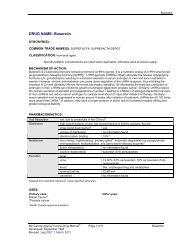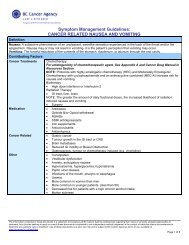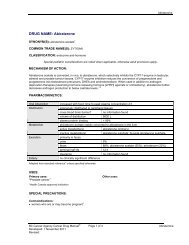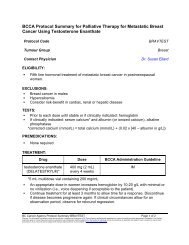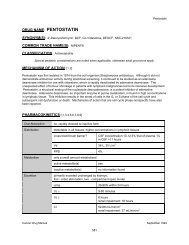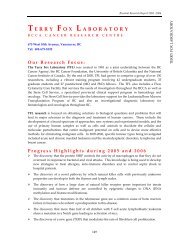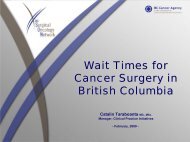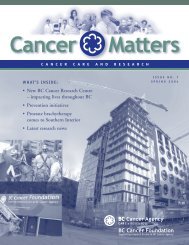DRUG NAME: Everolimus - BC Cancer Agency
DRUG NAME: Everolimus - BC Cancer Agency
DRUG NAME: Everolimus - BC Cancer Agency
You also want an ePaper? Increase the reach of your titles
YUMPU automatically turns print PDFs into web optimized ePapers that Google loves.
<strong>Everolimus</strong><br />
Localized and systemic infections, including pneumonia and other bacterial infections, invasive fungal infections,<br />
and viral infections, have been reported in up to 37% of patients. Infections are sometimes severe, leading to<br />
respiratory or hepatic failure, and fatalities have been reported. Prompt diagnosis and treatment of infection is<br />
important. Consider interruption or discontinuation of everolimus treatment. If invasive systemic fungal infection<br />
occurs, discontinue everolimus. 3<br />
Non-infectious pneumonitis, reported in 14% of patients, is a class effect of rapamycin derivatives. Severe and<br />
fatal cases have been reported. Symptoms include hypoxia, pleural effusion, cough or dyspnea. Patients should be<br />
advised to promptly report any new or worsening respiratory symptoms. Patients who develop radiological changes<br />
suggestive of non-infectious pneumonitis and have few or no symptoms may continue without dose alteration. If<br />
symptoms are moderate to severe, consider treatment interruption until symptoms improve. Corticosteroids may be<br />
indicated. <strong>Everolimus</strong> may be reinitiated at a reduced dosage of 5 mg daily based on patient response. 3,5,7<br />
INTERACTIONS:<br />
AGENT EFFECT MECHANISM MANAGEMENT<br />
cyclosporine 3,6<br />
erythromycin 3,6<br />
grapefruit juice 3,6<br />
ketoconazole 3,6<br />
live vaccines 3,4,6<br />
rifampin 3,6<br />
verapamil 3,6<br />
increased AUC and Cmax<br />
of everolimus (possibly<br />
dependent on cyclosporine<br />
formulation); increased<br />
serum creatinine and<br />
increased risk of<br />
thrombotic disorders<br />
increased Cmax and AUC<br />
of everolimus<br />
may increase plasma level<br />
of everolimus<br />
increased Cmax, AUC,<br />
and half-life of everolimus<br />
diminished therapeutic<br />
effect of vaccine,<br />
increased susceptibility to<br />
vaccinial infections<br />
increased clearance and<br />
reduced Cmax and AUC of<br />
everolimus<br />
increased Cmax and AUC<br />
of everolimus<br />
moderate inhibition of P-<br />
glycoprotein by<br />
cyclosporine; possible<br />
competitive inhibition of<br />
CYP 3A4 by everolimus<br />
moderate inhibition of CYP<br />
3A4 and P-glycoprotein by<br />
erythromycin<br />
may inhibit CYP 3A4<br />
metabolism of everolimus<br />
in the intestinal wall<br />
strong inhibition of CYP<br />
3A4 and P-glycoprotein by<br />
ketoconazole<br />
possibly decreased ability<br />
to generate a humoral<br />
response to the vaccine<br />
strong induction of CYP<br />
3A4 and P-glycoprotein by<br />
rifampin<br />
moderate inhibition of CYP<br />
3A4 and P-glycoprotein by<br />
verapamil<br />
monitor renal function and<br />
blood concentrations of<br />
both; may reduce<br />
everolimus dose to 5 mg,<br />
a further dose reduction to<br />
5 mg every other day may<br />
be required; cyclosporine<br />
dose adjustments may<br />
also be required<br />
avoid if possible; if used<br />
concurrently, may reduce<br />
everolimus dose to 5 mg,<br />
a further reduction to 5 mg<br />
every other day may be<br />
required<br />
avoid grapefruit and<br />
grapefruit juice during<br />
treatment<br />
avoid if possible<br />
avoid vaccination during<br />
treatment and for 3<br />
months following 4<br />
avoid if possible; may<br />
consider increasing<br />
everolimus dose 4<br />
avoid if possible; if used<br />
concurrently, may reduce<br />
everolimus dose to 5 mg,<br />
a further dose reduction to<br />
5 mg every other day may<br />
be required<br />
<strong>Everolimus</strong> is a substrate of CYP 3A4 enzyme and a substrate and moderate inhibitor of the efflux transport protein P-glycoprotein.<br />
Absorption and subsequent elimination of everolimus may be influenced by agents affecting CYP 3A4 and/or P-glycoprotein. Coadministration<br />
with strong inhibitors or inducers of either CYP 3A4 or P-glycoprotein should be avoided if possible. Co-<br />
<strong>BC</strong> <strong>Cancer</strong> <strong>Agency</strong> <strong>Cancer</strong> Drug Manual © Page 5 of 7 <strong>Everolimus</strong><br />
Developed: 01 November 2010<br />
Revised: 1 June 2013




